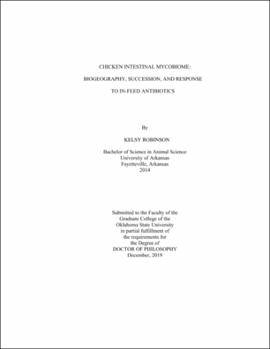| dc.contributor.advisor | Zhang, Guolong | |
| dc.contributor.author | Robinson, Kelsy | |
| dc.date.accessioned | 2020-06-26T21:27:52Z | |
| dc.date.available | 2020-06-26T21:27:52Z | |
| dc.date.issued | 2019-12 | |
| dc.identifier.uri | https://hdl.handle.net/11244/324874 | |
| dc.description.abstract | In-feed antibiotics increase animal performance primarily through modulation of the intestinal microbiota. However, the exact mechanism of action is not understood. Furthermore, a majority of research on intestinal microbiota has focused solely on the intestinal bacterial population with very little being known about smaller populations such as fungi. Deep sequencing of the internal transcribed spacer 2 (ITS2) region of fungal rRNA genes was utilized in two studies to characterize the biogeography of the chicken intestinal fungal community, the mycobiome, along the gastrointestinal tract of broiler chickens on days 28 and 42 and its possible shift in response to bacitracin methylene disalicylate (BMD), a commonly used in-feed antibiotic. Intestinal luminal contents were also collected from the duodenum, jejunum, ileum, and cecum at seven different time points throughout an entire production cycle to determine the succession of the mycobiome. The phyla Ascomycota and Basidiomycota were found to be predominant regardless of age or GI location. Genera commonly associated with feed ingredients or soil such as Microascus, Gibberella, Trichosporon, and Aspergillus were the most abundant. However, their abundance varied greatly between studies indicating a strong environmental influence. A clear succession of the cecal mycobiome was observed, in which specific fungal consortia moved down the intestinal tract as birds aged indicating that this population is transient in nature. Dietary supplementation of BMD at a subtherapeutic level of 55 mg/kg resulted in a decrease in the cecal fungal diversity. To further elucidate effect of antibiotics on cecal bacterial populations, broiler chicks were supplemented with or without one of five commonly used antibiotics for 14 days followed by deep sequencing of the V3-V4 region of the bacterial 16S rRNA gene. Although each antibiotic modulated the gut microbiota differently, the closer the antibacterial spectrum, the more similarly the microbiota is regulated with treatments classified as ionophores having the greatest effect. Importantly, all antibiotics had a strong tendency to enrich butyrate- and lactic acid-producing bacteria, while reducing bile salt hydrolase-producing bacteria, suggesting in-feed antibiotics improve animal growth performance through enhanced metabolism and utilization of dietary carbohydrates and lipids and improved energy harvest. | |
| dc.format | application/pdf | |
| dc.language | en_US | |
| dc.rights | Copyright is held by the author who has granted the Oklahoma State University Library the non-exclusive right to share this material in its institutional repository. Contact Digital Library Services at lib-dls@okstate.edu or 405-744-9161 for the permission policy on the use, reproduction or distribution of this material. | |
| dc.title | Chicken intestinal mycobiome: Biogeography, succession, and response to in-feed antibiotics | |
| dc.contributor.committeeMember | Conway, Tyrell | |
| dc.contributor.committeeMember | Burnap, Rob | |
| dc.contributor.committeeMember | Ritchey, Jerry | |
| osu.filename | Robinson_okstate_0664D_16558.pdf | |
| osu.accesstype | Open Access | |
| dc.type.genre | Dissertation | |
| dc.type.material | Text | |
| dc.subject.keywords | antibiotic alternatives | |
| dc.subject.keywords | antimicrobial growth promoters | |
| dc.subject.keywords | broiler | |
| dc.subject.keywords | chicken | |
| dc.subject.keywords | fungi | |
| dc.subject.keywords | mycobiome | |
| thesis.degree.discipline | Animal Science | |
| thesis.degree.grantor | Oklahoma State University | |
